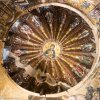Istanbul: Chora
The Church of the Holy Saviour in Chora is a medieval Byzantine Greek Orthodox church preserved as the Chora Museum in Istanbul. In the 16th century, during the Ottoman era, the church was converted into a mosque; it became a museum in 1948.
The Chora Church was originally built early in the 4th century as part of a monastery complex outside the walls of Constantinople, to the south of the Golden Horn. Originally the church stood outside of Constantine’s walls around the city. However, when Theodosius built his much longer walls in 413–414, the church became incorporated within the city's defences. Although not as large as some of the other surviving Byzantine churches in Istanbul, it is unique among them because of its almost completely original internal decoration.
The interior of the building is covered with some of the oldest and finest surviving Byzantine mosaics and frescos. Due to the prohibition against iconic images in Islam, the mosaics and frescoes were hidden behind a layer of plaster in the 16th century and were only uncovered and restored after the building was secularized and turned into a museum after 1948. Most of the current building dates from 1077–1081, when the church was rebuilt as an inscribed cross, a popular architectural style of the time. Early in the 12th century, the church suffered a partial collapse, perhaps due to an earthquake. The church structure was rebuilt, but it was only in the 14th century that the church as it stands today was completed with its fine mosaics and frescos, some of the finest examples available anywhere.
The Chora Church was originally built early in the 4th century as part of a monastery complex outside the walls of Constantinople, to the south of the Golden Horn. Originally the church stood outside of Constantine’s walls around the city. However, when Theodosius built his much longer walls in 413–414, the church became incorporated within the city's defences. Although not as large as some of the other surviving Byzantine churches in Istanbul, it is unique among them because of its almost completely original internal decoration.
The interior of the building is covered with some of the oldest and finest surviving Byzantine mosaics and frescos. Due to the prohibition against iconic images in Islam, the mosaics and frescoes were hidden behind a layer of plaster in the 16th century and were only uncovered and restored after the building was secularized and turned into a museum after 1948. Most of the current building dates from 1077–1081, when the church was rebuilt as an inscribed cross, a popular architectural style of the time. Early in the 12th century, the church suffered a partial collapse, perhaps due to an earthquake. The church structure was rebuilt, but it was only in the 14th century that the church as it stands today was completed with its fine mosaics and frescos, some of the finest examples available anywhere.
















